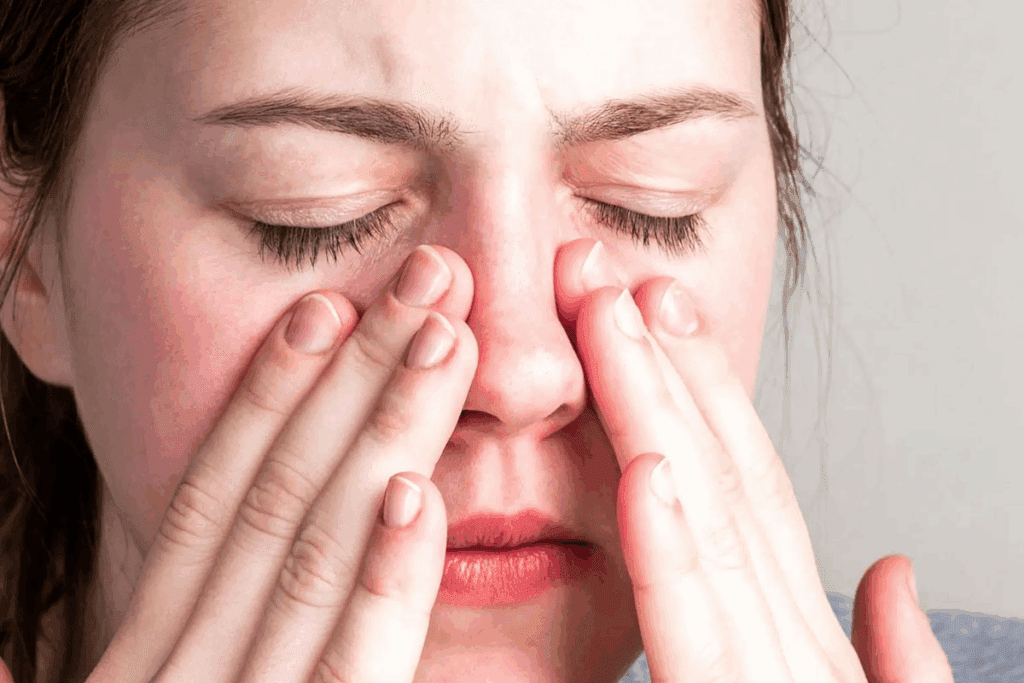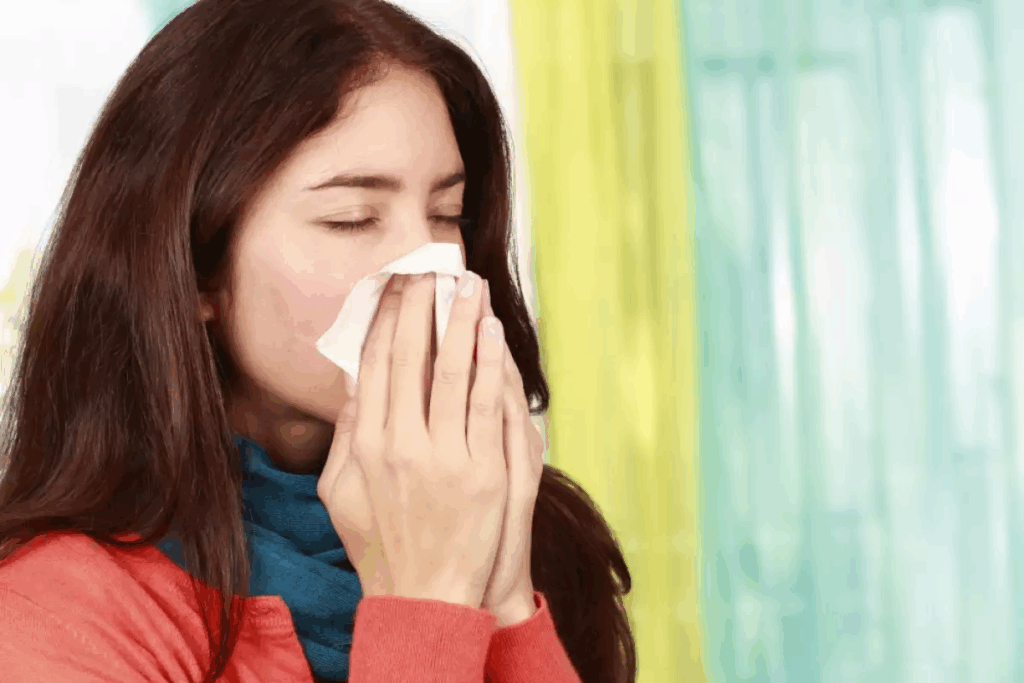Last Updated on October 31, 2025 by Saadet Demir

A complete guide to chronic sinusitis therapy, covering both pharmaceutical treatments and surgical interventions.
Chronic rhinosinusitis affects about 14.6% of people in the United States. It causes long-lasting and often severe symptoms. These symptoms include nasal congestion, facial pressure, and a reduced sense of smell.
This condition has a complex cause. Its diagnosis and treatment need a detailed plan. At Liv Hospital, we offer top-notch medical care and focus on you. We aim to help you manage chronic rhinosinusitis effectively.

Chronic rhinosinusitis affects millions worldwide. It’s a complex condition that needs a deep understanding for proper management. We’ll explore its definition, how it’s diagnosed, its prevalence, and the difference between chronic sinusitis and chronic rhinosinusitis.
CRS is when the nasal and sinus mucosa gets inflamed for more than 12 weeks. To diagnose CRS, you need to have symptoms like nasal congestion, discharge, facial pain, and smell loss for at least 12 weeks. You also need to have one objective finding, like purulent discharge or polyps, confirmed by a doctor.
The American Academy of Otolaryngology says,
“Chronic rhinosinusitis is a clinical diagnosis based on a combination of symptoms and objective findings on nasal endoscopy or imaging studies.”
CRS affects about 12% of adults in the United States. It has a big economic impact. This includes healthcare costs, lost productivity, and a lower quality of life.
People often confuse “chronic sinusitis” and “chronic rhinosinusitis.” But they mean different things. Chronic rhinosinusitis is the correct term because it includes both the nasal passages and sinuses. It’s a more accurate term that shows the condition’s complexity.

Chronic sinus disease is caused by a mix of problems. These include issues with the lining of the sinuses and how the body fights off infections. Chronic rhinosinusitis (CRS) is a long-term condition. It makes the lining of the sinuses inflamed and infected.
Inflammation is key in CRS. It involves many types of cells working together. These cells release substances that cause symptoms like stuffy nose, discharge, and pain in the face.
Key inflammatory mechanisms include:
Mucociliary clearance is vital for keeping the airways clean. It involves cilia moving mucus and pathogens out. In CRS, this process is often not working right.
This makes it hard for mucus and pathogens to be cleared. It helps infections and inflammation last longer.
Biofilms are groups of microorganisms stuck together. In CRS, they help bacteria stay and fight off treatments. They also make it hard for the immune system to work.
Knowing how CRS works is key to treating it. We need to tackle inflammation, improve how the body clears mucus, and stop biofilms. This can help patients feel better and live better lives.
It’s important to know the symptoms and causes of chronic rhinosinusitis to manage it well. This condition greatly affects a person’s life, causing many symptoms that can be very hard to deal with.
People with CRS often have nasal congestion, rhinorrhea, facial pain, and smell problems. These cardinal symptoms help doctors diagnose CRS and see how severe it is.
Nasal congestion and rhinorrhea are common, caused by long-term inflammation and trouble clearing mucus. Facial pain can be different for everyone and gets worse when bending forward.
CRS can have many causes, like inflammation, infections, and physical issues. Chronic inflammation is a big part of CRS, often from allergies, environmental factors, or conditions like asthma.
Bacterial and fungal infections can also play a role in CRS, making it harder to treat. Knowing the causes helps doctors find the right treatment.
Some things increase the chance of getting CRS. These include allergies, asthma, weak immune systems, and physical issues like nasal polyps or a crooked septum.
Knowing these risk factors helps doctors give better care. This can lead to better results for people with CRS.
Diagnosing chronic rhinosinusitis (CRS) involves many steps. We look at symptoms and use tests to find the cause. This helps us know for sure if someone has CRS.
Checking a patient’s symptoms and medical history is key. We look for signs like nasal congestion and facial pain. We also see how well treatments worked before.
CT scans are important for seeing how bad the inflammation is. They show if there are any problems with the sinuses. Endoscopy lets us see inside the nose and sinuses directly.
Endoscopy helps us take samples for tests. This can show if there’s an infection or allergy.
It’s important to know if CRS is caused by allergies. We look at allergy history and how symptoms change. Tests like skin prick tests can confirm allergies.
The first step in treating chronic sinusitis often involves medications to reduce inflammation and help drainage. We use a mix of medical treatments and lifestyle changes to manage chronic sinus disease.
Intranasal corticosteroids are key in treating chronic rhinosinusitis (CRS). They help by reducing inflammation in the nasal passages. This makes symptoms like congestion and loss of smell better.
Benefits of Intranasal Corticosteroids:
Saline irrigation is also a first-line treatment for CRS. It involves rinsing the nasal passages with a saline solution. This helps remove debris and promotes healing.
Device | Description | Benefits |
Neti Pot | A device used to rinse the nasal passages with saline solution | Effective for removing debris and reducing mucus |
Squeeze Bottle | A bottle that delivers saline solution into the nasal passages | Easy to use and portable |
Antibiotics are not always the first choice for CRS. But, they might be needed if there’s a bacterial infection. The right antibiotic should be chosen based on culture results, and treatment should be short to avoid resistance.
Knowing about treatments like intranasal corticosteroids, saline irrigation, and antibiotics helps us create a good plan for chronic sinus disease. This plan can make symptoms better and improve life quality.
Managing CRS involves several treatments to lessen inflammation and improve mucociliary function. This approach is key to managing symptoms and improving life quality for patients.
Macrolide antibiotics are used in CRS treatment for their antimicrobial and anti-inflammatory effects. Long-term, low-dose macrolide therapy helps reduce inflammation and improve symptoms, mainly in patients without nasal polyps.
“The anti-inflammatory properties of macrolides make them an effective treatment option for CRS patients, reducing symptoms and improving quality of life,” studies show.
Oral corticosteroids quickly relieve severe CRS symptoms, including those with nasal polyposis. But, long-term use can cause side effects. Short courses of oral corticosteroids are helpful during acute flare-ups, but use must be monitored.
Oral corticosteroids quickly reduce inflammation and improve symptoms. Yet, their long-term use can lead to side effects, requiring careful prescribing.
Leukotriene modifiers and antihistamines are also used in CRS treatment, mainly for those with allergic rhinitis or aspirin-exacerbated respiratory disease. Leukotriene modifiers help reduce inflammation and improve symptoms. Antihistamines manage allergic symptoms that can contribute to CRS.
“The use of leukotriene modifiers in CRS management represents a valuable therapeutic strategy, specially for patients with specific comorbid conditions.”
In conclusion, managing CRS requires a personalized approach with various treatments. Understanding the benefits and limitations of each strategy helps healthcare providers offer effective care to CRS patients.
Changing your lifestyle and using home remedies can greatly improve life for those with chronic rhinosinusitis (CRS). By adjusting daily habits and the environment, people can manage their symptoms better. This helps reduce how often symptoms get worse.
Managing CRS starts with controlling your environment. This means avoiding allergens and irritants. Here are some ways to do it:
Your diet is key in managing CRS. Making some changes can help. Here are a few:
Changing what you eat can really help with CRS symptoms. It’s important to talk to a healthcare provider about the best diet for you.
Drinking enough water and managing humidity are important for healthy sinuses. Here’s how:
Keeping the right balance of water and humidity can ease CRS symptoms. It also helps keep your sinuses healthy.
For those with chronic rhinosinusitis who haven’t seen results from usual treatments, new options are available. These advanced treatments aim to bring relief and enhance life quality for those with this tough condition.
Endoscopic sinus surgery is a top choice for chronic rhinosinusitis that hasn’t gotten better with medicine. This surgery uses an endoscope to see inside the sinuses and clear out blockages or diseased tissue. It helps improve sinus drainage and ventilation, reducing symptoms and improving life quality.
The surgery is done under general anesthesia or conscious sedation, making sure patients are comfortable. Advanced endoscopic tools allow for precise removal of bad tissue while keeping healthy mucosa.
Balloon sinuplasty is another advanced treatment for chronic rhinosinusitis. It uses a balloon catheter to open up blocked sinus ostia, improving drainage without removing tissue. Its minimally invasive nature makes it a good choice for those wanting to avoid big surgeries.
Balloon sinuplasty can be done alone or with endoscopic sinus surgery, depending on the patient’s needs. It has been shown to effectively improve sinus symptoms and lessen the need for future treatments.
For those with chronic rhinosinusitis that’s hard to treat, new biologic therapies offer hope. These therapies target specific parts of the inflammatory process, giving a more tailored treatment. Biologic agents like monoclonal antibodies have shown to reduce inflammation and improve symptoms in those who didn’t respond to usual treatments.
Though in the early stages, biologic therapies are a big step forward in treating chronic rhinosinusitis. As we learn more about the condition, we’ll see even more targeted and effective treatments.
Chronic rhinosinusitis is a tough condition to manage. We’ve looked into its causes, symptoms, and treatment options. It’s a complex issue.
Managing it well means a detailed plan. This includes medical care, lifestyle changes, and sometimes surgery. Knowing the symptoms and causes helps doctors give better care.
Every patient is different, so treatment must be tailored. This might include nasal sprays, saline rinses, and antibiotics. Changing your environment and diet can also help.
With a thorough management plan, we can make life better for those with chronic rhinosinusitis. Our aim is to ease symptoms and improve their overall health.
Chronic rhinosinusitis is a long-term condition. It causes inflammation in the nasal passages and sinuses for more than 12 weeks.
Symptoms include nasal congestion, facial pressure, loss of smell, and nasal discharge.
Doctors use clinical evaluation, CT scans, and endoscopy. These help check the nasal passages and sinuses.
Chronic sinusitis is just about the sinuses. Chronic rhinosinusitis affects both the nasal passages and sinuses. It’s a more complete term.
First-line treatments include intranasal corticosteroids, saline irrigation, and antibiotics. They help reduce inflammation and improve symptoms.
Intranasal corticosteroids reduce inflammation. This helps alleviate symptoms like congestion and facial pressure.
Changes include environmental controls, dietary considerations, staying hydrated, and managing humidity. These can help alleviate symptoms and improve quality of life.
Surgery, like endoscopic sinus surgery or balloon sinuplasty, is considered for those who haven’t responded to medical treatment.
New biologic therapies target inflammation pathways. They offer new treatment options for those with refractory chronic rhinosinusitis.
While it’s a chronic condition, effective management can significantly improve symptoms and quality of life.
Biofilm formation can lead to persistent infection and inflammation. This makes chronic rhinosinusitis challenging to treat.
Macrolide antibiotics have anti-inflammatory effects. They help manage chronic rhinosinusitis, in addition to their antimicrobial properties.
National Center for Biotechnology Information. (2025). How to Treat Chronic Rhinosinusitis A Complete Guide. Retrieved from https://pmc.ncbi.nlm.nih.gov/articles/PMC7700823/
Subscribe to our e-newsletter to stay informed about the latest innovations in the world of health and exclusive offers!
WhatsApp us